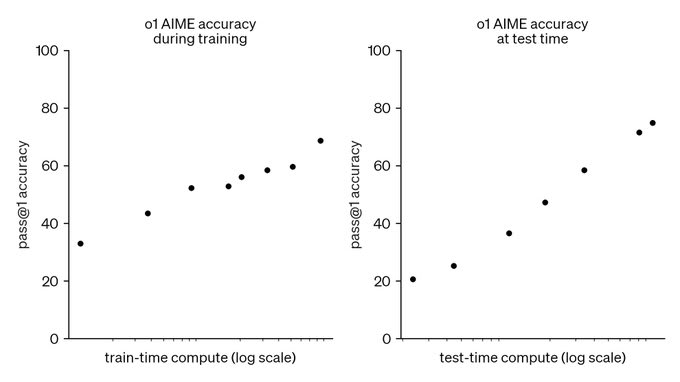This graph is the biggest update to the AI alignment discourse since GPT-3

For those of you unfamiliar with the lore, prior to GPT-3, the feeling was that AGI would rapidly foom based on recursive-self improvement.
After GPT-3, it became clear that the first AGI would in reality be built in a large lab using a multi-billion dollar supercomputer and any idea that it simply "copy itself to the internet" is nonsense.
Under the GPT-3 regime, however, it was still plausible to assume that the first AGI would be able to simulate millions of human beings. This is because the training cost for models like GPT-3/4 is much higher than the inference cost.
However, COT/o1 reveals this is not true. Because we can scale both training and inference, the first AGI will not only cost billions of dollars to train, it will also cost millions of dollars to run (I sort of doubt people are going to go for exact equality: spending $1b each on training/inference, but we should expect them to be willing to spend some non-trivial fraction of training compute on inference).
This is also yet another example of faster is safer. Using COT (versus not using it) means that we will achieve the milestone of AGI sooner, but it also means that we will have more time to test/evaluate/improve that AGI before we reach the much more dangerous milestone of "everyone has AGI on their phone".
Scaling working equally well with COT also means that "we don't know what the model is capable of until we train it" is no longer true. Want to know what GPT-5 (trained on 100x the compute) will be capable of? Just test GPT-4 and give it 100x the inference compute. This means there is far less danger of a critical first try since newer larger models will provide efficiency improvements moreso than capabilities improvements.
Finally, this is yet another example of why regulating things before you understand them is a bad idea. Most current AI regulations focus on limiting training compute, but with inference compute mattering just as much as training compute, such laws are out of date before even taking effect.
It's counterintuitive in the sense that a 24 kilowatt machine trained using a 24 megawatt machine turns out to be producing cognition cheaper per joule than a 20 watt brain. I think it's plausible that a GPT-4 scale model can be an AGI if trained on an appropriate dataset (necessarily synthetic). They know wildly unreasonable amount of trivia. Replacing it with general reasoning skills should be very effective.
There is funding for scaling from 5e25 FLOPs to 7e27 FLOPs and technical feasibility for scaling up to 3e29 FLOPs. This gives models with 5 trillion parameters (trained on 1 gigawatt clusters) and then 30 trillion parameters (using $1 trillion training systems). This is about 6 and then 30 times more expensive in joules per token than Llama-3-405B (assuming B200s for the 1 gigawatt clusters, and further 30% FLOP/joule improvement for the $1 trillion system). So we only get to 6-12 watts and then 30-60 watts per LLM when divided among LLM instances that share the same hardware and slowed down to human equivalent speed. (This is an oversimplification, since output token generation is not FLOPs-bounded, unlike input tokens and training.)